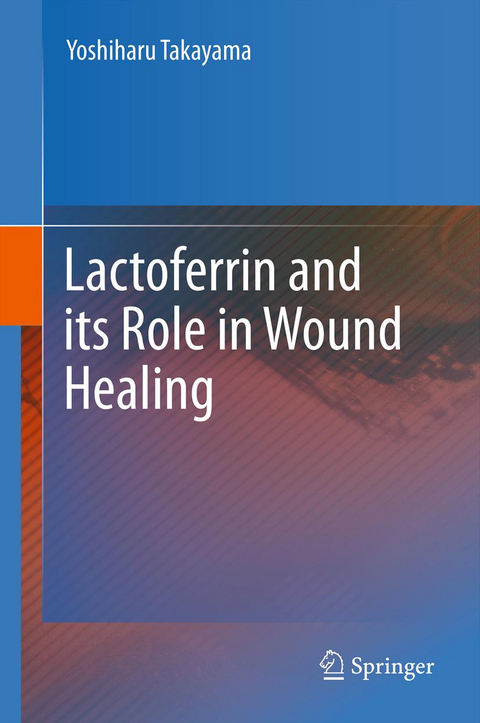
Lactoferrin and its Role in Wound Healing
Seiten
2013
Springer (Verlag)
978-94-007-9202-9 (ISBN)
Springer (Verlag)
978-94-007-9202-9 (ISBN)
These observations suggest that lactoferrin promotes the wound healing by providing an ECM that promotes fibroblast migration. According to recent in vivo study, lactoferrin promotes wound repair by promoting the early inflammatory phase of wound healing.
Lactoferrin is an iron-binding glycoprotein belonging to the transferrin family. It acts as a defense in host animals against microbes and viruses, since it has a broad spectrum of antimicrobial and antiviral activities. Lactoferrin has been shown to regulate the growth and differentiation of many types of cells. The results of recent studies indicate that lactoferrin is a potent regulator of dermal fibroblasts, and promotes cutaneous wound healing. The collagen gel contraction, a model of wound contraction during wound healing process, and migration of human fibroblasts were enhanced by lactoferrin. LRP-1 (LDL Receptor related Protein-1) acts as a signaling receptor for lactoferrin that mediate fibroblast response to lactoferrin by activating ERK/MAPK signaling pathway.
In addition, lactoferrin promotes biosynthesis of extracellular matrix (ECM) component such as type-I collagen and hyaluronan. Hyaluronan is a major component of ECM in connective tissue and promotes wound healing. The promoting effect of lactoferrin on hyaluronan production was accompanied by promotion of HAS2 (hyaluronan synthase 2) expression. These observations suggest that lactoferrin promotes the wound healing by providing an ECM that promotes fibroblast migration.
Lactoferrin is also known for its anti-inflammatory and immune modulating properties. According to recent in vivo study, lactoferrin promotes wound repair by promoting the early inflammatory phase of wound healing. Based on this, recombinant human lactoferrin was subsequently tested clinically in a Phase II trial in patients with diabetic ulcers and was found to be effective. Lactoferrin should be further evaluated in patients with diabetic and other types of ulcers.
Lactoferrin is an iron-binding glycoprotein belonging to the transferrin family. It acts as a defense in host animals against microbes and viruses, since it has a broad spectrum of antimicrobial and antiviral activities. Lactoferrin has been shown to regulate the growth and differentiation of many types of cells. The results of recent studies indicate that lactoferrin is a potent regulator of dermal fibroblasts, and promotes cutaneous wound healing. The collagen gel contraction, a model of wound contraction during wound healing process, and migration of human fibroblasts were enhanced by lactoferrin. LRP-1 (LDL Receptor related Protein-1) acts as a signaling receptor for lactoferrin that mediate fibroblast response to lactoferrin by activating ERK/MAPK signaling pathway.
In addition, lactoferrin promotes biosynthesis of extracellular matrix (ECM) component such as type-I collagen and hyaluronan. Hyaluronan is a major component of ECM in connective tissue and promotes wound healing. The promoting effect of lactoferrin on hyaluronan production was accompanied by promotion of HAS2 (hyaluronan synthase 2) expression. These observations suggest that lactoferrin promotes the wound healing by providing an ECM that promotes fibroblast migration.
Lactoferrin is also known for its anti-inflammatory and immune modulating properties. According to recent in vivo study, lactoferrin promotes wound repair by promoting the early inflammatory phase of wound healing. Based on this, recombinant human lactoferrin was subsequently tested clinically in a Phase II trial in patients with diabetic ulcers and was found to be effective. Lactoferrin should be further evaluated in patients with diabetic and other types of ulcers.
1. Molecular regulation of wound healing, - 2. Role of hyaluronan in wound healing, - 3. Lactoferrin structure, function and genetics, - 4. Lactoferrin as a signaling mediator, - 5. Effects of lactoferrin on skin wound healing
| Zusatzinfo | XII, 108 p. |
|---|---|
| Verlagsort | Dordrecht |
| Sprache | englisch |
| Maße | 155 x 235 mm |
| Themenwelt | Studium ► 1. Studienabschnitt (Vorklinik) ► Physiologie |
| Naturwissenschaften ► Biologie ► Biochemie | |
| Naturwissenschaften ► Biologie ► Zellbiologie | |
| Schlagworte | Granulation tissue • Hyaluronan • Lactoferrin • Reepithelialization • wound healing |
| ISBN-10 | 94-007-9202-6 / 9400792026 |
| ISBN-13 | 978-94-007-9202-9 / 9789400792029 |
| Zustand | Neuware |
| Haben Sie eine Frage zum Produkt? |
Mehr entdecken
aus dem Bereich
aus dem Bereich


